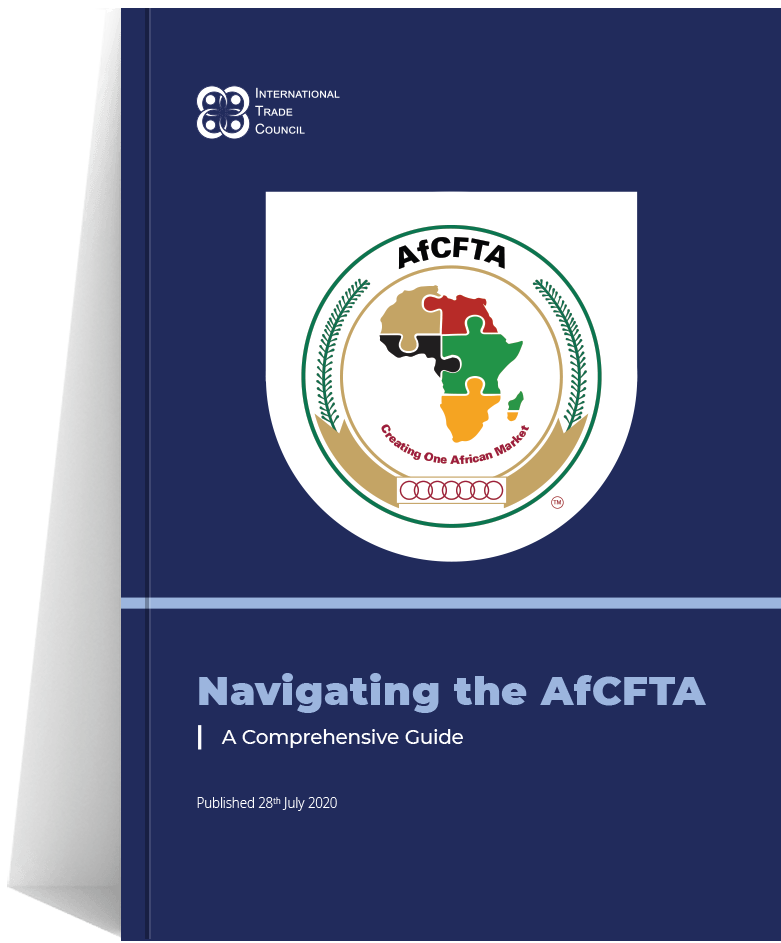About the Book
As the world's largest free trade zone, the African Continental Free Trade Area (AfCFTA) provides unprecedented prospects for firms wishing to export to Africa. This historic deal includes 54 of the 55 African Union member countries, with a combined GDP of more than $3 trillion and a population of more than 1.3 billion people.
This book aims to give businesses the tools and knowledge they need to tap into Africa's tremendous potential. It serves as a practical guide for businesses looking to comprehend the complexities of the AfCFTA Agreement, identify attractive sectors and industries, establish effective market entrance strategies, and assure compliance with numerous legal and regulatory requirements.

Chapter Previews
Foreword
Foreword by Solomon Addai, ITC Chairperson for Ghana (Emeritus)
A New Era for African Trade
Origins of the AfCFTA
The AfCFTA's Goals
AfCFTA Agreement Key Components
The Significance of the AfCFTA for Businesses
AfCFTA Member Countries
The AfCFTA's Goals
AfCFTA Agreement Key Components
The Significance of the AfCFTA for Businesses
AfCFTA Member Countries
Understanding the AfCFTA Framework
Components of AfCFTA
Regional Economic Communities (RECs) and their role in the AfCFTA
Tariff liberalization and rules of origin
Non-tariff barriers and their impact on trade
Regional Economic Communities (RECs) and their role in the AfCFTA
Tariff liberalization and rules of origin
Non-tariff barriers and their impact on trade
Understanding the Regulatory Framework
Importance of Compliance with Rules and Regulations for Trade in Africa
Key Documents and Agreements
Tariffs and Rules of Origin
Non-Tariff Barriers
Intellectual Property Rights
Investment and Dispute Resolution
Key Documents and Agreements
Tariffs and Rules of Origin
Non-Tariff Barriers
Intellectual Property Rights
Investment and Dispute Resolution
Export Opportunities under the AfCFTA
Identifying Promising Sectors and Industries
Agriculture and Agribusiness
Manufacturing
Infrastructure and Construction
Health and Pharmaceuticals
Renewable Energy
Information and Communication Technology (ICT)
Tourism and Hospitality
Education and Training
Mining and Minerals
Creative Industries
Agriculture and Agribusiness
Manufacturing
Infrastructure and Construction
Health and Pharmaceuticals
Renewable Energy
Information and Communication Technology (ICT)
Tourism and Hospitality
Education and Training
Mining and Minerals
Creative Industries
Understanding the Differences in African Markets
Central Africa
East Africa
North Africa
Southern Africa
West Africa
East Africa
North Africa
Southern Africa
West Africa
Strategies for Market Entry
Conducting Market Research
Developing a Market Entry Strategy
Partnering with Local Businesses
Developing a Local Presence
Building Relationships
Adapting to Local Culture
Addressing Infrastructure Challenges
Managing Risks
Building a Strong Brand
Investing in Innovation
Creating an Inclusive and Diverse Workforce
Leveraging Technology
Establishing Strong Partnerships
Focusing on Customer Service
Developing a Market Entry Strategy
Partnering with Local Businesses
Developing a Local Presence
Building Relationships
Adapting to Local Culture
Addressing Infrastructure Challenges
Managing Risks
Building a Strong Brand
Investing in Innovation
Creating an Inclusive and Diverse Workforce
Leveraging Technology
Establishing Strong Partnerships
Focusing on Customer Service
Managing Supply Chains and Logistics
Importance of Supply Chain Transparency and Due Diligence
Infrastructure and Transportation Options in Africa
Managing Customs and Cross-Border Trade
Best Practices for Efficient and Sustainable Supply Chain Management
Infrastructure and Transportation Options in Africa
Managing Customs and Cross-Border Trade
Best Practices for Efficient and Sustainable Supply Chain Management

